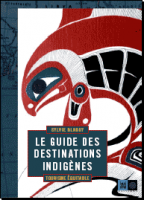Photos : Page Burt
Project description :

In 2004, Bathurst Inlet Lodge (BIL), Canada’s oldest naturalist lodge, celebrated 35 years of ecotourism. It is a place of spectacular views, 24-hour summer daylight, rare species (e.g., caribou, muskox) climatic extremes, and a culture surviving thousands of years. The tiny community of Bathurst Inlet is populated by Inuit. Historically, they survived by living off the land (for food, clothing, tools, fuel, shelter) so the Hudson’s Bay Company (HBC) established a trading post to tap into the fruits of these labours. A small RC church was built in the 1930s, and the community saw the presence of the Canadian government mainly via infrequent patrols by the Royal Canadian Mounted Police. In the 1960s, fur prices crashed, the HBC trading post and the church closed, and the Inuit fell on hard times. Glenn Warner, who had been with the RCMP patrolling into the community by dogteam and boat, then saw an opportunity to share both the friendliness of the local people and the spectacular place with his family. He obtained permission to buy the church and the historic HBC buildings, and in 1969 established BIL.
Activities offered :
Subsequently, a plan was developed to help the Inuit purchase half the lodge. Now with joint Inuit ownership, decisions on all aspects of the operations are made together (community-managed). Co-owners form one big family, which is something guests immediately feel as the Inuit share their knowledge of the land, wildlife, and culture. They are friendly, enthusiastic, and radiate community pride. This is particularly evident in the weekly cultural program of cross-cultural sharing, when the boat captain interprets the use of traditional tools and implements and describes traditional activities, the soapstone lamp with sealskin oil is lit ; and traditional clothing is modelled by all ages including toddlers. Guests are also invited to share their own culture (e.g., via poems, stories, dance). Although the evening is voluntary, everyone in the tiny community squeezes in to attend and share with their global visitors. It is obvious the hearts of the community are in this common experience.
BIL has comfortable bedrooms, full amenities, a gathering room with a stupendous view, and an incredible library. It includes books, artifacts, illustrations, and other resources, and can be a place for slide presentations, activities, or local crafts sales (all proceeds going directly back to the artist). There are daily programs on sea (using a fuel-efficient pontoon boat which allows wildlife observation and impromptu lectures) and land, where guided birdwatching, hiking, natural history interpretation and cultural exploration (e.g., finding ancient stone tent rings or camps, meat caches, fox traps, drying rocks, canoe rests, or inuksuit) take place, tapping into specialist expertise and traditional indigenous knowledge.
Access to the lodge is only via boat or plane. Visitors take a wheeled or floatplane from Yellowknife, organised by BIL (included in the cost of the visit) and this trip is wonderful in itself, with pilots pointing out herds of caribou and other interesting sights. Although visitors may see the wonderful spring carpets of Arctic flowers and summer blooms, BIL is in the Arctic so is only open for a short summer season, and there is a maximum of 20 visitors at any one time, which creates a very special experience. BIL was recognised in 2003 by Travel & Leisure Magazine as one of the “World’s 25 Top Ecolodges” for providing exceptional programming on Arctic culture, history, flora and fauna, and was featured as an Ecoclub.com interview in March 2003 (http://ecoclub.com/news/046/interview.html). Bathurst Inlet Lodge enabled the Inuit of the community to both participate in the cash economy and retain their way of life, and lodge charters have provided an inexpensive way of getting foods, materials, and other items to the community. Due to steady increases in the cost of living in the Arctic, including heating oil, and the need for medical services, and a need to see their children get an education, Inuit residents can no longer live year-round at Bathurst Inlet. However the families return in summer to their beloved “Nuna”, and the traditional experiences that mean so much to them. The government of Nunavut has recognised the efforts of BIL, and at that place, the cabinet produced the “Bathurst Mandate”, a document setting major directions for their work across Nunavut.
Contact :
Boyd Warner, General Manager
Address : P.O. Box 820, Yellowknife, NWT, Canada X1A 2N6
Telephone : (867) 873-2595
Fax : (867) 920-4263
Email : boydw@bathurstinlet.com
E-mail Pam Wight : pamwight@superiway.net
Website : http://bathurstarctic.com/
Language : English
View online : Bathurst Inlet Lodge



